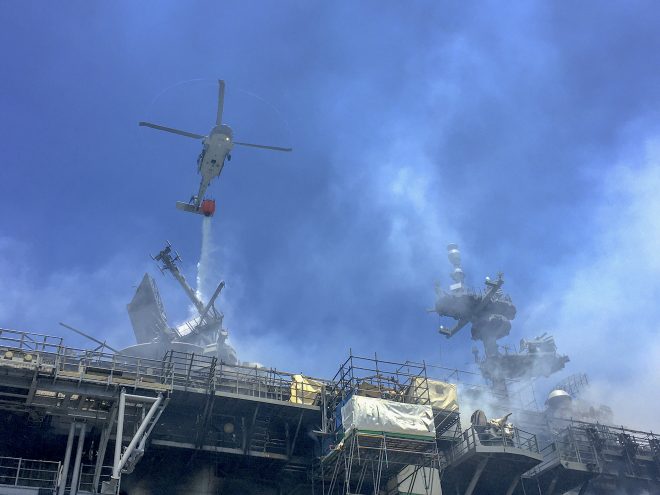
The following are the command investigation into the July 12, 2020 fire aboard the former USS Bonhomme Richard (LHD-6) and the Major Fires Review. The pair of reports were released on Oct. 20.
From the Command Investigation
Executive Summary
On 12 July 2020, a fire set USS BONHOMME RICHARD (LHD-6) ablaze for more than four days, and left the ship damaged beyond economical repair. Although the fire was started by an act of arson, the ship was lost due to an inability to extinguish the fire. In the 19 months executing the ship’s maintenance availability, repeated failures allowed for the accumulation of significant risk and an inadequately prepared crew, which led to an ineffective fire response. There were four key focus areas to this final outcome:
- Material Condition. Throughout the maintenance period, the material condition of the ship was significantly degraded, to include heat detection capability, communications equipment, shipboard firefighting systems, miscellaneous gear clutter, and combustible material accumulation. To illustrate the extent of degradation, on the morning of the fire, 87% of the ship’s fire stations remained in inactive equipment maintenance status.
- Training and Readiness. The training and readiness of Ship’s Force was marked by a pattern of failed drills, minimal crew participation, an absence of basic knowledge on firefighting in an industrial environment, and unfamiliarity on how to integrate supporting civilian firefighters. To illustrate this point, the crew had failed to meet the time standard for applying firefighting agent on the seat of the fire on 14 consecutive occasions leading up to 12 July 2020.
- Shore Establishment Support. The integration and support expected by the shore establishment did not adhere to required standards. Southwest Regional Maintenance Center (SWRMC) did not meet their requirements associated with fire safety and, in doing so, failed to communicate risk to leadership while facilitating unmitigated deviations from technical directives. Naval Base San Diego (NBSD) failed to ensure its civilian firefighters were familiar with Navy vessels on the installation, verify they were trained to respond to a shipboard fire, or effectively practice how to support Ship’s Force and simultaneously integrate responding mutual aid assets.
- Oversight. Ineffective oversight by the cognizant Commanders across various organizations permitted their subordinates to take unmitigated risk in fire preparedness. A significant source of this problem was an absence of codification of the roles and responsibilities expected by each organization in their oversight execution.
Common to all four focus areas was a lack of familiarity with key policies and requirements along with procedural non-compliance at all levels of command from the unit level to programmatic, policy, and resourcing decisions. An example of how these focus areas combined to result in unacceptable levels of risk is the status of the ship’s Aqueous Film Forming Foam sprinkling system. At no point in the firefighting effort was it used – in part because maintenance was not properly performed to keep it ready and in part because the crew lacked familiarity with capability and availability.
Command Investigation Into the Fire Aboard USS Bonhomme Richard (LHD-6) 12 July 2021
Download the document here.
Major Fires Review
Download the document here.
"Review" - Google News
October 20, 2021 at 09:51PM
https://ift.tt/3pp4TGb
Navy Investigation into USS Bonhomme Richard Fire, Major Fires Review - USNI News - USNI News
"Review" - Google News
https://ift.tt/2YqLwiz
https://ift.tt/3c9nRHD
Bagikan Berita Ini















0 Response to "Navy Investigation into USS Bonhomme Richard Fire, Major Fires Review - USNI News - USNI News"
Post a Comment